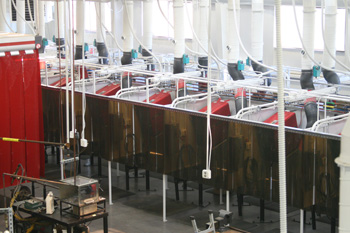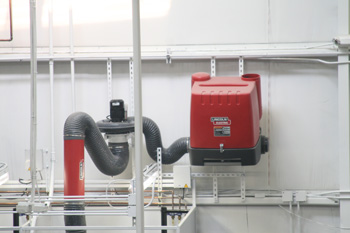Alabama’s Wallace State Community College Puts Latest Welding Education Technologies to Work in New Laboratory Facility
The sluggish economy hasn’t put a damper on the need for workers in the skilled trades. Nor has it slowed enrollment in welding education programs, particularly at community colleges. These programs continue to grow and attract students, providing real-world welding training and experience to the next generation of skilled workers – abilities in high demand in the industrial and manufacturing sectors.
At Wallace State Community College in Hanceville, Ala., enrollment in the school’s welding education program has doubled since 2007. School officials opted to enlarge the program’s facilities to accommodate increased enrollment and to expand its state-of-the art training programs to even better prepare students for welding manufacturing careers.
“There are a couple of different areas in the state where industry is booming big time, and companies cannot find enough qualified personnel. Good skilled welders can get jobs anywhere,” says Jim Thompson, department head for the college’s welding program. “Training at a state-of-the art facility further attracts students and helps build their real-world skill sets. Our goal is to have our students come out of school and enter the workforce ready to perform.”
The Wallace State welding department routinely turns out highly skilled graduates who move on to well-paying careers in the welding industry. Its students follow an intensive curriculum and receive certification from the American Welding Society (AWS) and the National Center for Construction Education and Research (NCCER) after they meet all necessary requirements.
Additionally, many bring home awards from both state skills competitions and wider reaching contests, such as SkillsUSA. In fact, Wallace State boasts three consecutive state winners in 2009, 2010 and 2011, as well as the national winner in 2009, in the welding skills category.
First-Class Makeover
With such a focus on welding technology and training, it’s no surprise that the college embarked upon its ambitious renovation of the welding department’s facilities. The school’s refurbished welding lab opened this winter after seven months of construction and was completely transformed from its former self.
“We completely rebuilt the lab area,” Thompson says. “We gutted it from corner to corner and started over. We reorganized welding booths and added the latest in welding technologies.”
The project was funded through a variety of grants, including Region 2 Workforce Council funding for the new equipment. The extensive makeover increased the number of welding booths in the lab to 35 and added 18 booths to a modular unit just outside the facility. These additions allow instructors to accommodate as many as 53 students at a time, in comparison to just 23 booths prior to renovations.

“We wanted a wide range of equipment that represented the most recent technology, including pulse welding,” Thompson explains.
“We definitely want to try to get our students familiar with this type of welding, even though not everyone in the industry has grasped that technology yet.”
Attention to IAQ (Indoor Air Quality)
One of the major design changes in the lab was a clear focus on air quality improvements. Each of the welding stations now features fume extraction equipment designed to improve indoor air quality in the lab. Fume control equipment eliminates dust, fumes and pollutants from work areas, and as Thompson points out, one of his main goals during the renovation was to create a healthier, cleaner environment in the lab.
“If you are going to build a new, state-of-the-art facility, you also need to address the issue of fume extraction,” Thompson said. “We wanted to accurately replicate a well-fitted industrial setting for our students. We feel we need to fully emulate what is going to happen in industry, and regulations definitely are pushing industry toward using these systems.”

The college also added two mobile Mobiflex® 200-M welding fume control units for use with its training and certification testing program, which it provides for local industry in its role as one of only three AWS-accredited testing facilities in Alabama.
“Our students initially didn’t understand what the big deal was with fume extraction. But, after the first three weeks, one of the students didn’t have the arm close enough to the arc to pull off the fume. Everyone noticed it immediately. It was an excellent lesson to demonstrate how important it is to have that arm positioned correctly over the arc and how much of an advantage these systems are in pulling away smoke and fume,” Thompson says. “They will leave here well educated on how emissions affect a workplace and how to improve the working environment with fume extraction.”
Virtual Welding Training Capabilities
At Wallace State, however, welding education begins before students even enter an actual welding booth, let alone their first jobs.

With a VRAW™ system, welding technology comes to life in a 3D environment. Users put on a real welding helmet and pick up a MIG gun or stick electrode holder to lay down a weld in a virtual world, thanks to special virtual reality displays embedded in the system’s customized welding helmet.
High-resolution images and software immerse the student in a realistic virtual environment that also features sounds and visual feedback to supplement the learning experience. Additionally, as the students “weld” in this environment, instructors can – in real time – suggest modifications and adjustments they need to make as the students are welding. The system also scores students on welding proficiency and technique on a number of relevant parameters, providing pertinent feedback throughout the process.
“They all start with the VRTEX® and stay on it for a couple of weeks,” Thompson says of new welding students entering the training program at Wallace State. “With this kind of equipment, they start to grasp what they can do in terms of different kinds of welding and how all sorts of factors can affect productivity and weld quality.
Once Thompson’s students leave the virtual welding arena and go into the welding booth, they are better prepared for what to expect in the real world, he says.
“Virtual welding teaches students how to save time, money and materials in a classroom setting and then allows them to take this knowledge of cost savings on power, welds and time out into the lab and, eventually, into the field,” Thompson notes.
Well-Rounded Education
While Wallace State welding students get both a virtual look at the process through the VRTEX® 360 system and hands-on experience in actual welding booths outfitted with the latest in welding technology, Thompson still incorporates classroom lectures into the curriculum. He believes qualified welders not only need to be able to weld skillfully but also have crucial business savvy, such as understanding how to run a successful and safe welding shop

Thompson says the excitement over the new facility has caused word to spread about Wallace State’s already well-regarded welding program. While enrollments typically are largest in the fall, the program had 16 new students join the program in January when the new semester started in conjunction with the unveiling of the new welding lab.
“Students are excited about the renovations and the chance to learn in a first-class facility,” he says. “It’s truly a place where they can come in and get up to speed with the latest technology but also understand how the industry works and how they can run a successful welding business. It’s a true approximation of a real-world setting.”
